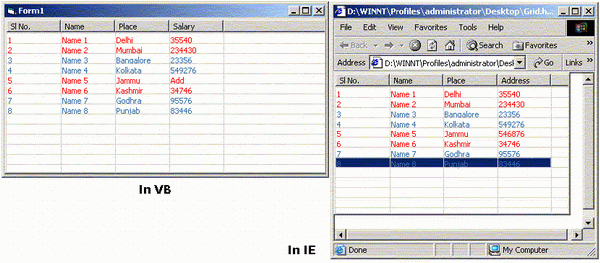Edit Listview Subitem In Vb6 Instrument

Robin, Are you using VB6 and the Listview control from that? If memory serves me correctly, the listitems and subitems are 0 based collections. So if you have 3 columns, they should be indexed 0-2. VB6: Debug.Print ListView1.ListItems(0).SubItem(0).Text Debug.Print ListView1.ListItems(0).SubItem(2).Text If you are using Visual Basic 2005, then you need to change your code since the new control has an Items collection, not a ListItems collection. Here is code for.Net. VB2005: Debug.Print(ListView1.Items(0).SubItems(0).Text) ListView1.Items(0).SubItems(0).Text = 'foo' Adam Braden Visual Basic Team. Robin, Are you using VB6 and the Listview control from that?
If memory serves me correctly, the listitems and subitems are 0 based collections. So if you have 3 columns, they should be indexed 0-2. VB6: Debug.Print ListView1.ListItems(0).SubItem(0).Text Debug.Print ListView1.ListItems(0).SubItem(2).Text If you are using Visual Basic 2005, then you need to change your code since the new control has an Items collection, not a ListItems collection. Here is code for.Net.
Oct 04, 2004 vbCity is a community of VB and.NET developers joined together with a common goal: to learn, teach, and have fun programming. Developers from all over the world come together to share knowledge, source code, and tutorials for free to help their fellow programmers - Professional Developers, Hobbyists and Students alike. Nov 28, 2005 Hi, I have a listview with 3 columns, and some rows. I have searched the internet for a code to edit a value of a subitem. I found soms code, like: ListView1.ListItems(2).SubItems(3) = 'something', but this won't work. Does someone can help me? (Sorry for my limited English) Greetings, Robin Robin, Are you using VB6 and the Listview control from that.
VB2005: Debug.Print(ListView1.Items(0).SubItems(0).Text) ListView1.Items(0).SubItems(0).Text = 'foo' Adam Braden Visual Basic Team.
As I was finishing off the on the Windows Forms ListView, it occurred to me that there isn't much documentation around to explain how to edit the ListView items. So I thought it might be useful to cover a couple of approaches in this blog. If you're disappointed that there isn't a built-in way to edit all the items and sub items, the thing to bear in mind is that ListView is essentially a display control, rather than an editing one. That said, there is one built-in tool that you can use - but only as long as you are content to edit items in the first column exclusively. Edit First Column Only What you can do is set the ListView's LabelEdit property to True. You can set this via the Properties Window or in code, ideally in the Load Event. Private Sub Form2_Load( ByVal sender As Object, ByVal e As System.EventArgs) Handles Me.Load LVMVPs.LabelEdit = True End Sub Now, if you click on an item in the first column on any row, the data in the first column of the selected row will become editable.
I actually found that I had to triple-click, but I'm not sure if this is just a reflection of my mouse click speed settings or is the default requirement: If you have the FullRowSelect property set to True, you can click anywhere along the row and the item in the first column will become editable as shown in the screenshot above. If FullRowSelect is set to False then you do need to click directly on the first column. Edit Any Column You have to do a bit of work yourself if you want to be able to edit any cell in the ListView, but there isn't really much to it. To demonstrate the technique, I've added three TextBoxes and an Update button to the Form: The code below will allow the user to Right-click on any row and this will cause the three items of data in that row to be displayed in the three TextBoxes. Dim ItemSelected As ListViewItem. Private Sub btnConfirm_Click( ByVal sender As System.Object, ByVal e As System.EventArgs) Handles btnConfirm.Click ' Update ListView ItemSelected.SubItems(0).Text = TextBox1.Text ItemSelected.SubItems(1).Text = TextBox2.Text ItemSelected.SubItems(2).Text = TextBox3.Text ' Avoid confusion by clearing TextBoxes TextBox1.Clear() TextBox2.Clear() TextBox3.Clear() End Sub The content of each TextBox is transferred back to the relevant ListView sub item (regardless of whether it has been changed - although you could of course build in a filter here if you wanted to).
The TextBoxes are then cleared. And for a simple project, that's really all there is to it. Gta 4 dmg download. As you can see, I did also add a button to clear the ListView, but that was just for my own convenience, so I could test multiple consecutive edits without duplicating the data in the file.